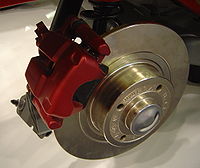
Photo from wikipedia
In the present work, different ventilated disc brake rotor configurations were analysed to enhance the heat transfer rate and obtain the uniform temperature distribution in the rotor. CFD code used… Click to show full abstract
In the present work, different ventilated disc brake rotor configurations were analysed to enhance the heat transfer rate and obtain the uniform temperature distribution in the rotor. CFD code used in this work was validated at using experimental results obtained by conducting experiments on a test rig. The experimental analysis was performed to calculate the mass flow rate and heat dissipation through the rotor. Further, different types of rotor configurations viz. straight radial vane (SRV), tapered radial vane (TRV), alternate long and short vane (ALSV), variable diameter circular pillars (VDCP) were considered for the analysis. A rotor segment of 20° was considered for the numerical analysis due to its rotational symmetry. CFD results were in good agreement with the experiments. The maximum deviation of the numerical results were about 12 % from the experimental results. It is found from the analysis that among the different types of rotor configurations; variable diameter circular pillars (VDCP) rotor gives better rate of heat dissipation with more uniform temperature distribution in the flow passages. Hence for modern high speed vehicles VDCP rotor may be more appropriate.
Journal Title: International Journal of Automotive Technology
Year Published: 2017
Link to full text (if available)
Share on Social Media: Sign Up to like & get
recommendations!